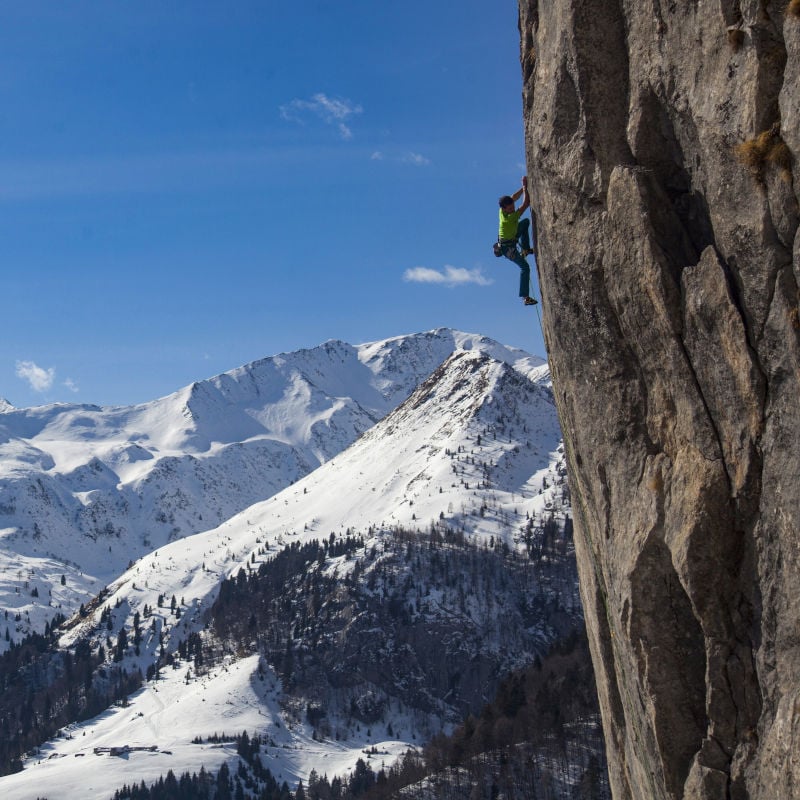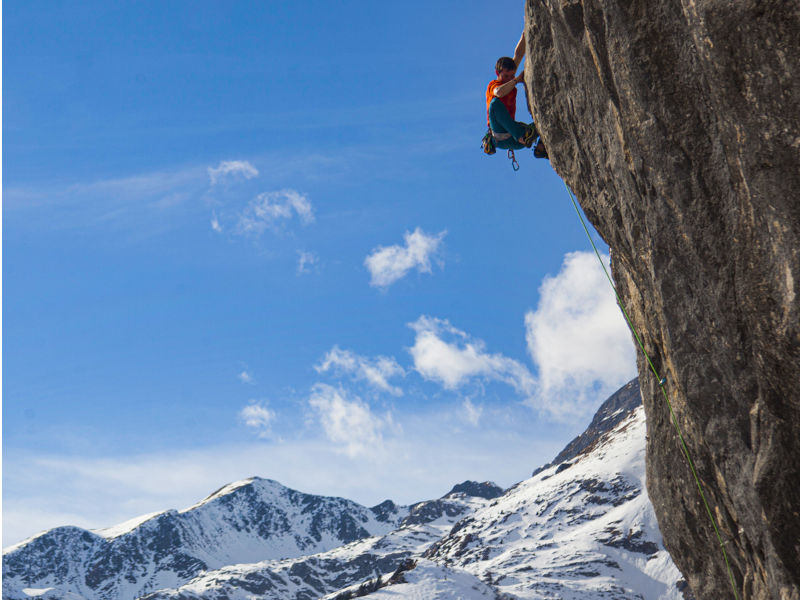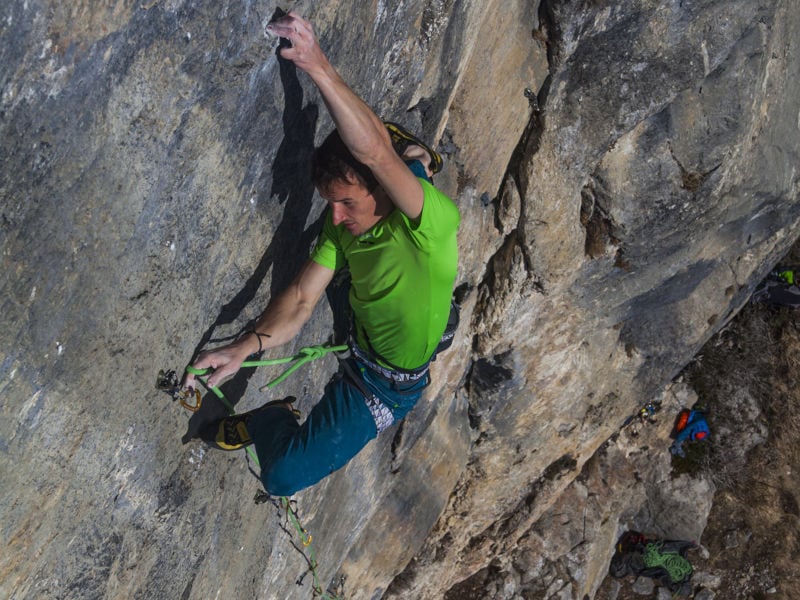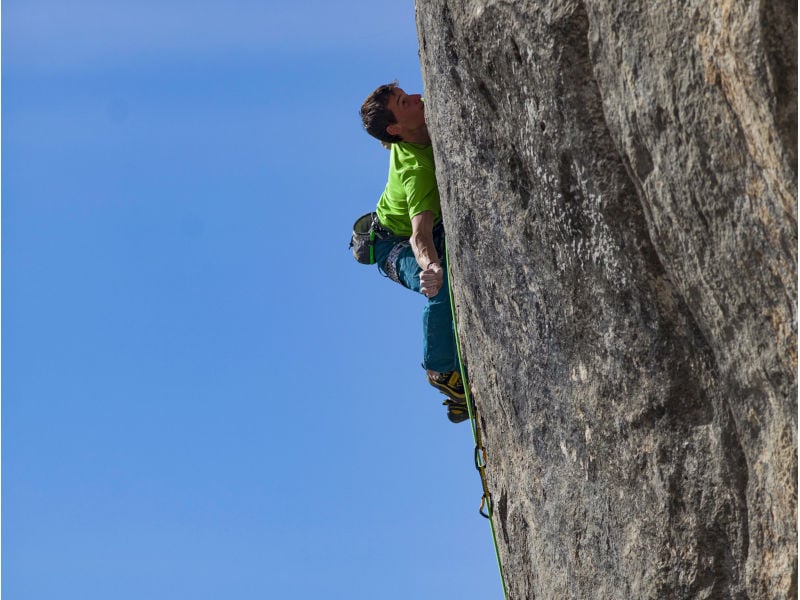
Sometimes magic happens in seconds, when everything aligns perfectly. Like when you raise your eyes to the sky in the summer and see a shooting star. At that moment, it doesn’t matter what intentions or wishes you expressed, but the fact that your heart was filled with wonder and for a moment you smiled. What matters is that when you saw that trail of light, you let go of everything that was weighing you down, together with that star. It matters that for an instant your soul resonated, caressed by an invisible breath. It matters that in the middle of an infinite night sky, you gazed at that light that caused you to look at things with new eyes, making you feel alive.
Today I want to tell you about a particular place, an isolated one-of-a-kind rock wall: the “Scogliera” crag at Passo Monte Croce Carnico.
The Scogliera features limestone of the highest quality, at times rough and painful, at other times smooth and elusive. The beauty of the climbs and the aesthetics of the lines make it a real jewel — a rock barrier 70 meters high and about 200 meters long that extends from east to west, right on the border between Italy and Austria. Today there are approximately 100 routes on this beautiful and sunny face, all full of character. The compactness of the rock requires perfect use of the feet, strong fingers, and a good head.
Climbing here, I’ve learned, more than anywhere else, that a lot of humility is needed. On each of these delicate vertical journeys, the wall immediately spits you back if you make a mistake in positioning yourself, causing you to fall. I learned that on the Scogliera there are really no “easy routes” because here what’s easy never translates into trivial. So, even on warm-up pitches you need concentration, calm, and awareness. Maybe it’s precisely for this reason that this gorgeous face isn’t very popular. The difficulty of the climb is a barrier that protects it from the crowds typical of other places, but once they get past this initial wall, the small number who remain will be able to enjoy truly exceptional climbing!
Throughout the year, many hikers, following the historical World War II trail that climbs to the top of Pal Piccolo from Passo Monte Croce, pass right under this huge wall and often stop to stare curiously at the few climbers who frequent it.
In the winter, though, the snow covers that path and the flow of people coming and going is interrupted. A respite for the forest animals, which regain possession of their space. It’s a location with breathtaking views, silent, isolated — one of those places that, for me, embody the beauty of climbing and going to the mountains. It’s a crag that carries the history and evolution of free climbing in those border areas, and it’s here where my story begins.

When I first went up there, I remember being enchanted by a very compact rock shield on the left side of this huge wall. Going up the path, as soon as I turned the corner I looked up, and immediately my gaze was captivated by a huge monolith 40 meters high, with incredible aesthetics. That thin line rising right in the middle seemed truly impenetrable. I later discovered that the first pitch had already been freed, while its continuation was still a theoretical project.
So, at the beginning of last year, I began to inquire about who had bolted it and whether there had ever been a chance to try to free it. “Per aspera ad astra” was the name chosen for this route. A Latin phrase that literally means “through difficulties to the stars.”
I soon learned that the second part of that route had been equipped by the great Luciano Cimenti, aka “Cen.” A climber with great class, perhaps not well known, whom I’ve personally always highly respected. In the 1990s, Cen had freed a majority of the most challenging pitches in Carnia, significantly raising the bar of difficulty in the area. One day he told me that he had bolted that pitch in the late ’90s and that he had attempted it for some time but was unable to complete it.
I had already repeated some of Cen’s routes, and all of them had proved very demanding and difficult. The fact that he had not succeeded was undoubtedly an indication that it wouldn’t be an easy challenge! He told me that the project was open to anyone who was motivated to try to master it. I was very happy to be able to get my hands on that line, to try to discover its secrets, and to have something new and very inspiring to try. So I dove in! As often happens, though, the most beautiful things are also the most difficult and painful. That’s exactly what I first felt on “Per aspera…” That route, totally natural and with beautiful moves, forced me to hold very small, sharp blades that jabbed into the skin of my fingertips, to the point of cutting them.
The experience I’d gained over the years on this type of vertical climbing immediately made me realize that good physical condition wasn’t enough to climb this route; optimal weather conditions were necessary as well.

Nevertheless, in 2021 I spent a few days on that route during the summer, to try to decipher that series of holds that initially seemed to be placed randomly on the smooth wall. During those attempts, I realized that two bolts needed to be repositioned to allow more comfortable clipping. Cen gave me the green light, so I took my time arranging them and adding a real rest point on the edge.
The route was now in the right conditions to be free climbed. There was only one thing missing … the cold!
The Scogliera, in addition to being a technically difficult sector, is also exposed to the south at an elevation of about 1,400 meters above sea level. This characteristic means that it’s not easy to find the right weather conditions, especially on routes like “Per aspera ad astra,” where humidity and very low temperatures were required.
So I shifted my attention elsewhere, and at the beginning of November I managed to climb “Eternit.” I had to wait another month, until mid-December, when I decided it was the right time to go back to the Scogliera to try the route.
Several months had passed since my last attempt, and that day it was still far too hot to be able to free climb the route — although it was winter, the thermometer at the base of the sector showed a good 25 degrees! So I limited myself to reviewing the sequences, trying to make sense of the route. Then came the Christmas holidays, the panettone and the gifts, then came the snow, and finally, just when I wanted to go back up there, the pandemic also arrived, which forced me to stay isolated at home. A cruel joke that dimmed my hopes of being able to return to “Per aspera …”
On January 20, my girlfriend and I were finally free from isolation. Initially, I felt fatigued and tired from the COVID, but fortunately I quickly regained my form and resumed my training and climbing routine.
Then it also came time to do a week of preparation with my teammates from the High Mountain Military Section of the Army Sports Center. The week’s menu included ice climbing and dry tooling.
For me it was a first experience, an intense and very educational week. I can only thank my teammates for the valuable advice they shared with me.

How important is the visual beauty of a line to you? For me it can make all the difference! It’s what ultimately gives me the motivation to attempt a route for more than a day. It was precisely this that made me return once again to “Per aspera ad astra.”
So, I arrived on February 13 of this year. The day was perfect; the sky was absolutely clear, as it can only be on the most beautiful winter days. The profiles of the mountains were in “full HD.” No haze at all. The cold, dry wind from the north blew at the same speed as my dreams.
I set off with my girlfriend, Ilenia, toward Passo Monte Croce. Climbing up that narrow winding road, I was already thinking about the moves on the route: “Who knows if those same sensations … Who knows if today that sequence that frustrated me last time …” We climbed quickly along the path, and when we arrived at the crag we decided to do some warm-up pitches on the “i fucilieri” sector. This first sector is well known to be the easiest on Pal Piccolo, but if it’s really pleasant in the summer because it’s breezy, in the winter the air is channeled to this point and rises freezing cold from the bottom of the valley. Our fingers were soon cold, and we came down from the pitch like two icicles. So much for a warm-up!
We were colder than when we started, so we decided to move directly behind to the Scogliera sector, hoping for milder temperatures.
Around the corner, we were immediately greeted by a completely different microclimate — a light, cool breeze and a warm sun that thawed us, carrying away all the cold we had just accumulated.

There the conditions were absolutely perfect! I had intended to climb “Catherine’s pac,” a 7a that Ilenia was attempting. But we only had one rope with us, and she didn’t feel like tackling the route from below, so she convinced me to immediately attempt “Per aspera ad astra”: “You try first — that way you can put the rope up for me on this one and I can take my time on some pitches later.”
So once again we went to the base of that shield of rock, and I looked up. The stars were up there, but the road that awaited me in between had many difficulties to overcome!
The sensations were incredibly good right from the start. In a short time I reached the first belay, a 7c+ that was not exactly trivial. From here the route definitely changes gear, with the climb becoming more and more difficult, complex, and delicate. Proceeding with the ascent, the holds become smaller and sharper-edged until they turn into thin lines.
I took a deep breath and moved resolutely, precisely, and lightly. I started to get up, and the lack of a warm-up made me think, after every two moves, that I would surely get pumped on the next step. But the conditions that day were amazing, and I always found a way to relax, even in places where I usually had to bail. As soon as I reached those two small, elusive holes on the last slab, I realized that I was finally about to touch the stars. With a scream I grabbed that distant edge and with it this little dream of mine!
I would never have thought that I’d be able to climb this route with such speed and on the first attempt of the day! It was fortunate for Ilenia, who was able to work on her project at her own pace that day!

With regard to the difficulty, trying as always to be as objective as possible, taking into account the attempts made (about 15), and making a comparison with routes of a similar style and difficulty, I think that “Per aspera …” is easier than routes such as “Cosmic energy” and “Eternit” (9a+), but more difficult than “Bain de sang” (8c+/9a). The suggested grade is therefore 9a.
I would like to thank in particular Luciano “Cen” Cimenti, who, with his classy gesture of sharing, allowed me to free this beautiful route. It was an opportunity to really put myself to the test and a way to tell this story of places and people, which I hope will encourage some young climbers to approach this gorgeous face and these places that are still little known but of rare beauty.
I dedicate the ascent of “Per aspera ad astra” — the first proposed 9a grade in Carnia — to Gianni Cattaino, a doctor who, more than anyone else, has dedicated his life to serving others, bolting new routes and new crags in Carnia and beyond. A truly exquisite person whom I had the pleasure and the good fortune to meet, but who sadly passed last year in an unlucky accident in the mountains before he could complete the last crag he was preparing. Who knows how happy “Doc” will be to see that all the work he’s done over the years is still a source of happiness for every climber!
With this ascent I also want to remember Nicola Liessi, a young and talented climber from Carnia who once attempted to free this route. Even before me, Nicola had understood that it could be climbed. Unfortunately, I never had the opportunity to meet him in person; the difficulties of his life drove him to leave before I could even shake his hand. Perhaps from up there, among the infinite stars in the firmament, he will still be smiling, thinking: “I was right. I said so! You really could climb ‘Per aspera ad astra’!”
Gianni, Nicola … this is for you!
experience by
ALE ZENI